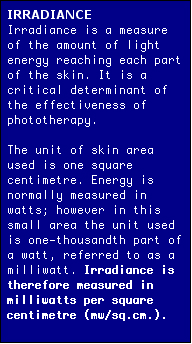 tubes are used the 2 ft (600mm) long tubes
are 18 watts and the 4ft (1200mm) tubes are 36 watts. Typical
overhead or underneath night phototherapy equipment with ten 4
ft (1200 mm) tubes or twenty 2 ft. (600 mm) tubes have power inputs
of 360 watts.
tubes are used the 2 ft (600mm) long tubes
are 18 watts and the 4ft (1200mm) tubes are 36 watts. Typical
overhead or underneath night phototherapy equipment with ten 4
ft (1200 mm) tubes or twenty 2 ft. (600 mm) tubes have power inputs
of 360 watts.
|
|
EFFECTIVENESS OF PHOTOTHERAPY
The effectiveness of phototherapy in controlling blood bilirubin levels depends on a number of factors. These include the following.
Wavelength Of Light
The use of light of optimum wavelength is fundamental to the effectiveness of phototherapy. The source of blue light should have a peak output at about 450 nanometers and a wavelength range not wider than 400 to 520 nanometers. The commonly used Phillips TL 52 fluorescent tubes (or the very similar Phillips BB tubes) are appropriately used in most phototherapy systems. (See the TL 52 spectrum analysis). The wavelength of the light is generally not a factor that differentiates between the effectiveness of different fluorescent tube based phototherapy equipment and systems.
Non User-specific Factors
Factors important to effectiveness of phototherapy for all users include the following.
1. Total power input (wattage) of fluorescent
tubes used. The greater the power
used the greater the irradiance (See box for meaning of Irradiance)
and effectiveness, provided the percentage of light wasted does
not increase. Where Phillips TL 52 or BB fluorescent  tubes are used the 2 ft (600mm) long tubes
are 18 watts and the 4ft (1200mm) tubes are 36 watts. Typical
overhead or underneath night phototherapy equipment with ten 4
ft (1200 mm) tubes or twenty 2 ft. (600 mm) tubes have power inputs
of 360 watts.
tubes are used the 2 ft (600mm) long tubes
are 18 watts and the 4ft (1200mm) tubes are 36 watts. Typical
overhead or underneath night phototherapy equipment with ten 4
ft (1200 mm) tubes or twenty 2 ft. (600 mm) tubes have power inputs
of 360 watts.
2. The freshness (or hours of use) of fluorescent tubes. This is a major, often under-recognised factor. The light energy output of fluorescent tube decreases substantially with the number of hours for which they have been used. Users report that the light output decreases by 35% by the end of 1200 hours (e.g. 120 days at 10 hours per day) of use. Philips suggest that, with optimal cooling, the decrease should be less, however the 35% fall-off may well be correct for systems actually in use. After 1200 hours of use, irradiance is only 65% that of new tubes. If used ten hours per day for a 120-day period, the average irradiance over the period is 17.5% less than that for new tubes.
3. Proximity of the light source to the skin. The intensity of light (irradiance) reaching the skin decreases with the distance from the light source. This means that a greater amount of energy is wasted on other surfaces and less light energy falls on the skin. It is therefore very important to have the skin as close as possible to the light source.
4. The extent to which light not directly falling on skin can be reflected back. Light that is wasted by not falling directly on skin is partially absorbed and partly reflected by other surfaces. For most surfaces, absorption of light energy is far larger than light reflected. Mirrors are the exception to this. Even where a percentage of reflection takes place, this is only of value if it is reflected on to the skin. Otherwise it gets absorbed on other surfaces. Maximum use of light energy produced takes place when mirrors reflect light back to the skin either directly or via other mirrors.
5. Energy lost through screens between the light source and the skin. Safety screens must be used between fluorescent tubes and the user. Typically these are clear acrylics that absorb less than 5 % of the irradiance. In some systems netting beds are also used and these typically absorb about 15% of the irradiance.
6. The area of skin exposed. The effectiveness of phototherapy is proportional to the amount of surface area of skin irradiate. Irradiance is measured in milliwatts per square centimetre (of skin). The larger the skin area exposed the greater amount of light energy is received to transform bilirubin.
7. The amount of time the skin is exposed. The effectiveness of phototherapy is proportional to the phototherapy time. The amount of phototherapy time required has often been used to indicate the seriousness of a persons CN condition. This is an unsatisfactory measure because it ignores the other factors listed here. Nevertheless, if all the other factors are constant, the effectiveness of the phototherapy depends directly on the amount of hours the skin is exposed to irradiation.
User Specific Factors
Some factors that determine the effectiveness of phototherapy for reduction of blood bilirubin concentration are specific to the user. These include
The most important factor is the acceptability and comfort of the phototherapy for the individual CNS person. All phototherapy systems place restrictions on users and adversely affect lifestyle to some extent.
The best designed phototherapy equipment from the point of view of irradiance and other non user-specific factors will have no value if the CNS person refuses to use it as required. The design of equipment must take into account the characteristics and the environment of the user.
The comparative effectiveness of different phototherapy systems should be examined using the above criteria.
Copyright 2006.